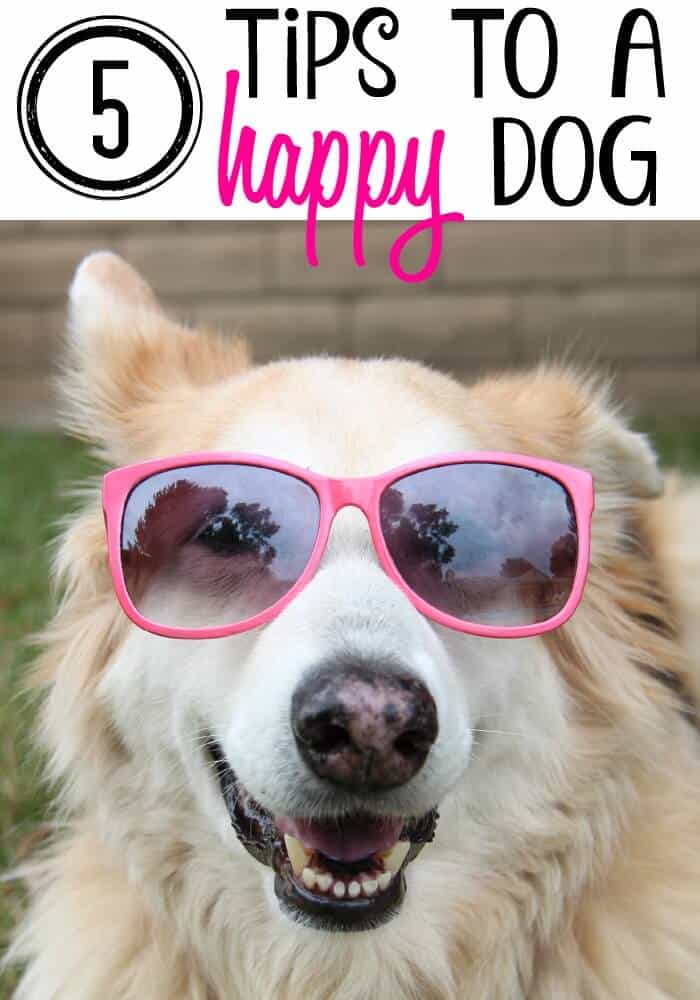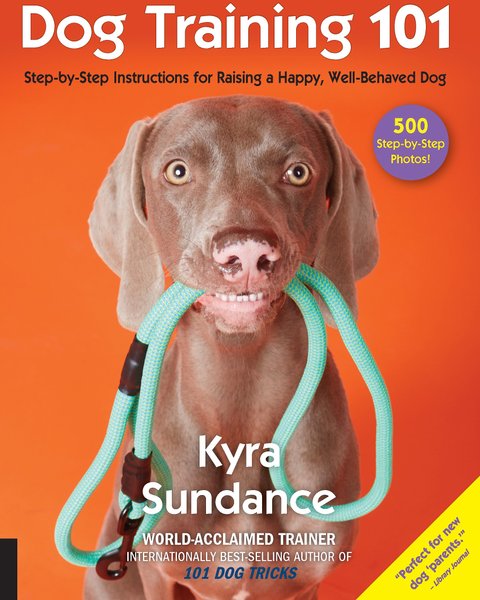To have a well-behaved dog, deal with bad habits early and reward good behavior. Ignoring bad behavior and shaping good behavior quickly creates a happy, well-behaved dog.
A well-behaved dog is a joy to have as a pet. They are well-mannered, obedient, and respectful of boundaries. However, achieving this level of behavior requires consistent training and guidance from their owners. We will discuss five tricks that can help in raising a well-behaved dog.
By implementing these tricks, you can ensure that your furry friend is a pleasure to be around and respected by others. So, let’s dive into the tricks and start shaping your dog’s behavior for the better!

Credit: www.madewithhappy.com
Establishing Basic Training
When it comes to having a well-behaved dog, establishing basic training is essential. This foundation sets the stage for a dog’s behavior and ensures that they understand what is expected of them. In this section, we will discuss two important aspects of basic training: rewarding good behavior and ignoring bad behavior.
Rewarding Good Behavior
One of the most effective ways to train your dog is by rewarding good behavior. Dogs respond well to positive reinforcement, and it helps them understand what behavior is desired. When your dog exhibits good behavior, such as sitting on command or walking calmly on a leash, make sure to praise and reward them. This can be done through treats, verbal praise, or a combination of both.
Ignoring Bad Behavior
While it may be tempting to reprimand or punish your dog for bad behavior, it is actually more effective to ignore it. When you give attention to negative behavior, it reinforces that behavior and can encourage your dog to continue engaging in it. Instead, focus your attention on redirecting your dog’s attention towards positive behaviors. For example, if your dog is jumping up on people, ignore them until they are calm and sitting, then reward them for their good behavior.
Establishing basic training is the foundation for a well-behaved dog. By consistently rewarding good behavior and ignoring bad behavior, you are effectively teaching your dog what is acceptable and what is not. Remember, patience and consistency are key when it comes to training your furry friend.

Credit: www.chewy.com
Proper Socialization
Socialization is crucial for a well-behaved dog. Follow these 5 tricks to properly socialize your furry friend for a happy and obedient companion.
Proper socialization is crucial for raising a well-behaved dog. It helps them learn how to interact with other dogs, humans, and their environment in a calm and controlled manner. With proper socialization, your furry friend will grow into a confident and well-adjusted companion. Here are some essential tricks you can use to ensure proper socialization for your dog.Early Socialization
One of the key factors in raising a well-behaved dog is early socialization. The critical period for socialization is between 3 and 14 weeks of age. During this time, puppies are more receptive to new experiences and less likely to develop fear or anxieties. Introduce your puppy to a variety of people, animals, and environments during this period to help them become comfortable and well-socialized. Some early socialization activities you can incorporate include:- Taking your puppy to meet new people, including children and individuals of different ages and ethnic backgrounds.
- Exposing your puppy to different sounds, such as traffic noise, doorbells, and vacuum cleaners, in a controlled and positive way.
- Introducing your puppy to other well-behaved and vaccinated dogs.
Frequent Socialization Outings
Socialization is an ongoing process that needs to be reinforced throughout your dog’s life. Frequent socialization outings are essential to maintain their social skills and reduce the risk of developing behavioral problems. Regularly exposing your dog to new environments, situations, and people helps them stay adaptable and confident in various settings. Consider these frequent socialization outings:- Visiting dog-friendly parks or beaches where your dog can interact with other dogs and owners.
- Taking your dog on walks in different neighborhoods to expose them to new sights, sounds, and smells.
- Enrolling your dog in a well-structured training class that incorporates socialization exercises.
Setting Clear House Rules
When it comes to having a well-behaved dog, setting clear house rules is crucial. Dogs, just like humans, need structure and boundaries to understand what behaviors are acceptable and what are not. By defining boundaries and consistently reinforcing them, you can ensure that your furry friend is on their best behavior. Here are some tricks to help you establish clear house rules for your dog.
Defining Boundaries
To set clear house rules for your dog, it is important to define their boundaries. Start by determining areas in your home where your dog is allowed and areas that are off-limits. Use baby gates or closed doors to create physical boundaries if needed. Additionally, establish rules about furniture and sleeping areas so your dog knows where they are allowed to relax. Consistency is key when defining these boundaries to avoid confusion for your dog.
Consistent Reinforcement
Once you have established your dog’s boundaries, it is vital to consistently reinforce the rules. This means rewarding good behavior and discouraging bad behavior immediately. Use positive reinforcement, such as treats or praise, to reward your dog when they follow the house rules. On the other hand, redirect their attention or use a firm “no” to discourage any behaviors that are not allowed. Consistent reinforcement helps your dog understand which behaviors are desired and which are not.
Providing Clear Signals
In addition to consistent reinforcement, it is essential to provide your dog with clear signals. Use visual cues, such as hand signals or gestures, to communicate commands and expectations to your dog. This helps them understand what is expected of them and reduces confusion. Additionally, use consistent verbal commands to reinforce your signals and create a clear language between you and your dog.
Establishing A Routine
A predictable routine is beneficial for both you and your dog. Establish a daily routine that includes regular feeding times, exercise, training sessions, and relaxation periods. Dogs thrive on routine, and by sticking to a schedule, you can create a sense of stability and security for your furry friend. A consistent routine also helps reinforce the house rules and reinforces positive behaviors.
Leading By Example
As a dog owner, you play a crucial role in setting the tone and leading by example. Dogs are highly observant and often imitate the behavior of their owners. Therefore, it is important to model the behavior you expect from your dog. If you want your dog to be calm and well-mannered, show them through your own actions. For example, if you want your dog to wait patiently at the door, demonstrate this behavior yourself. Leading by example helps your dog understand and adopt the house rules more easily.
Crate Training
Crate training is one of the tricks for a well-behaved dog. It helps in shaping good behavior and providing a safe space for your furry friend.
Introduction To Crate Training
Crate training can be a valuable tool in helping your dog become well-behaved. It provides them with a safe and comfortable space of their own, while also aiding in house training and preventing destructive behavior. However, it’s important to approach crate training in a positive and compassionate manner to ensure it is effective. Here are some tips to successfully crate train your dog:Positive Reinforcement
One of the key aspects of crate training is using positive reinforcement. When introducing your dog to the crate, make it a positive and rewarding experience. Encourage them to explore the crate by placing treats or their favorite toys inside. Use praise and affection when they willingly enter the crate and give them a treat as a reward. By associating the crate with positive experiences, your dog will start to view it as a safe and comfortable space.Establishing A Routine
Consistency is key when crate training your dog. Establishing a routine helps them understand when it’s time to go into the crate and when it’s time to come out. Create a schedule for feeding, bathroom breaks, playtime, and crate time. Stick to this routine as much as possible, as it will help your dog develop a sense of predictability and comfort. Be patient with them during the initial phases of crate training, as it may take time for them to adjust.Gradual Introductions
Introduce your dog to the crate gradually to prevent any feelings of fear or anxiety. Start by leaving the crate door open and allow them to explore it at their own pace. Once they are comfortable entering and exiting the crate, gradually close the door for short periods of time, increasing the duration over time. Remember to provide positive reinforcement during these sessions to encourage and reward their good behavior.Avoiding Confinement Abuse
It’s important to note that the crate should never be used as a form of punishment or confinement for long periods. The purpose of crate training is to create a positive and safe space for your dog, not to isolate or distress them. Make sure to provide ample exercise, mental stimulation, and socialization outside of the crate. Regularly check on your dog when they are in the crate to ensure they are comfortable and not experiencing any distress.Patience And Persistence
Crate training takes time and patience. Some dogs may take longer to adjust than others, and setbacks may occur. Stay calm, be patient, and continue reinforcing positive behavior with treats, praise, and affection. With consistent training and a positive approach, your dog will learn to see the crate as a peaceful retreat and will become well-behaved both inside and outside of it. Remember, crate training should always be approached with kindness and understanding. It is a tool to aid in your dog’s development and well-being, not a means of confinement or punishment. By following these tips, you can successfully crate train your dog and achieve a well-behaved canine companion.Discouraging Bad Behavior
Discover the top 5 tricks for a well-behaved dog and effectively discourage bad behavior. By focusing on rewarding good behavior and tackling bad habits early on, you can shape a happy and well-mannered canine companion.
Addressing Bad Behavior Immediately
When it comes to discouraging bad behavior in dogs, addressing it immediately is crucial. Ignoring or overlooking bad behavior can lead to it becoming a habit or escalating to more dangerous behaviors over time. By taking action right away, you can effectively communicate to your dog what behaviors are not acceptable. One effective way to address bad behavior immediately is through redirecting your dog’s attention. If you catch your dog chewing on something they shouldn’t, for example, calmly and firmly say “no” and then redirect their attention to an appropriate chew toy. This helps them understand what they should be chewing on and reinforces positive behavior.Consistent Correction
Consistency is key when correcting bad behavior in dogs. Dogs thrive on routine and structure, so it’s important to correct them consistently for the same behavior every time it occurs. This helps them understand that certain behaviors are not allowed in any circumstance. One way to ensure consistent correction is by using a specific cue or command when addressing bad behavior. For example, if your dog jumps on guests, teach them to “sit” instead. By using the same command every time your dog jumps, they will begin to associate the action with the command and eventually stop jumping altogether. Another important aspect of consistent correction is to avoid mixed signals. It’s crucial for all family members or caretakers to be on the same page when it comes to correcting bad behavior. Sending different messages to your dog can confuse them and make it more difficult for them to understand what is expected of them. In addition to consistent correction, it’s also essential to provide positive reinforcement when your dog exhibits good behavior. Rewarding them with treats, praise, or playtime can motivate them to continue behaving well and reinforce the desired behaviors. By addressing bad behavior immediately and providing consistent correction, you can effectively discourage unwanted behavior in your dog. Remember to be patient and consistent, as it may take time for your dog to fully understand and respond to the training. With consistent effort and positive reinforcement, you’ll be well on your way to having a well-behaved and happy furry companion.
Credit: dogtime.com
Frequently Asked Questions For 5 Tricks For A Well Behaved Dog
What Are The 5 Basic Commands For Dogs?
The 5 basic commands for dogs are: “sit,” “stay,” “come,” “down,” and “heel. “
How Do I Make My Dog Well-behaved?
To make your dog well-behaved, deal with bad behavior before it escalates. Ignore bad behavior and reward good behavior to shape your dog’s behavior. Follow these tips for a well-behaved dog: Set boundaries, train using positive reinforcement, socialize early, discourage bad behavior, and find their motivation.
How Do I Train My Dog To Be Well Mannered?
To train your dog to be well-mannered, start by addressing bad behaviors early. Ignore the bad and reward the good to shape their behavior. Teach basic manners like not jumping or biting and encourage calmness. Socialize them early and set rules in your home.
Make training positive and fun. Lastly, be consistent and discourage bad behavior immediately.
What Is The Most Well-behaved Dog?
The most well-behaved dog breeds include the Cavalier King Charles Spaniel, Golden Retriever, and Labrador Retriever.
Conclusion
When it comes to having a well-behaved dog, consistency is key. By following the five tricks outlined in this blog post, you can shape your furry friend into a happy and obedient companion. Remember to start training early, reward good behavior, and discourage bad habits right away.
Whether it’s crate training or socializing your dog, each tip contributes to creating a well-behaved dog. With patience, dedication, and positive reinforcement, your dog will become a well-mannered member of your family.







